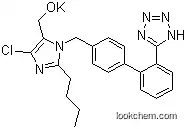Products Categories
| CAS No.: | 1310-58-3 |
|---|---|
| Name: | Potassium hydroxide |
| Article Data: | 1 |
| Molecular Structure: | |
|
|
|
| Formula: | KOH |
| Molecular Weight: | 56.1056 |
| Synonyms: | lpotassum hydroxide;kizutasaponin K10;Potassium h;potassium hydroxyde;Cauloside D;potassium hyroxide;Caustic potash;Potassium hydroxide;potassium hydroxid;caustic potash; |
| EINECS: | 215-181-3 |
| Density: | 2.044 g/cm3 |
| Melting Point: | 360 °C |
| Boiling Point: | 100 °C at 760 mmHg |
| Flash Point: | 52 °F |
| Solubility: | 121 g/100 mL (25 °C) in water |
| Appearance: | white solid |
| Hazard Symbols: |
 T, T, F, F, Xi, Xi, C C
|
| Risk Codes: | 34-35-22-11-39/23/24/25-23/24/25-36/38-36/37-67 |
| Safety: | 7-16-36/37-45-36/37/39-26 |
| Transport Information: | UN 2924 3/PG 2 |
| PSA: | 23.06000 |
| LogP: | -0.17680 |
- 144851-82-1METHYL2-AMINO-3-FLUOROBENZOATE
- 483366-12-7(2S,4R)-1-Boc-2-cyano-4-hydroxypyrrolidine
- 173606-50-3BOC-10-AMINODECANOIC ACID
- 361456-36-2METHYL (R)-(+)-ISOCYANATO-3-PHENYLPROPI&
- 5156-58-1N-(1-Benzyl-4-pipperidinyl)-N-phenylpropanamide HCl
- 81281-59-67-Benzylideneaminotheophylline
- 50288-62-5threo-Phenyl-2-piperidyl acetamide
- 82993-81-5D-threo-Ritalinic acid hydrochloride
- 47087-37-6Z-D-Glu-OMe
- 73441-42-6METHYL-5-CHLORO-2,2-DIMETHYLVALERATE

| Conditions | Yield |
|---|---|
| In water at 70℃; for 2h; Product distribution / selectivity; |

- 1310-58-3
potassium hydroxide

- 21339-47-9
diethyl 2-(2,2-diethoxyethyl)malonate

- 944334-17-2
potassium 4,4-diethoxy-2-ethoxycarbonylbutanoate

| Conditions | Yield |
|---|---|
| With ethanol at 20℃; for 4h; | 100% |

| Conditions | Yield |
|---|---|
| With water In tetrahydrofuran; acetonitrile at 20℃; for 1h; | 100% |
- 1310-58-3
potassium hydroxide

- 1056001-95-6
1-methyl-3-morpholin-4-ylmethyl-1H-indole-6-carboxylic acid methyl ester

- 1056001-96-7
potassium 1-methyl-3-morpholin-4-ylmethyl-1H-indole-6-carboxylate

| Conditions | Yield |
|---|---|
| With water; isopropyl alcohol at 55℃; for 24h; | 100% |
- 1310-58-3
potassium hydroxide

- 1056002-06-2
3-piperidin-1-ylmethyl-1H-indole-5-carboxylic acid methyl ester

- 1056002-07-3
potassium 3-piperidin-1-ylmethyl-1H-indole-5-carboxylate

| Conditions | Yield |
|---|---|
| With water; isopropyl alcohol at 55℃; for 24h; | 100% |
- 1310-58-3
potassium hydroxide

- 170097-66-2
3,4-Dihydro-1H-isoquinoline-2.6-dicarboxylic acid 2-tert-butyl ester-6-methyl ester

- 1055948-66-7
potassium 2-tert-butoxycarbonyl-1,2,3,4-tetrahydro-isoquinoline-6-carboxylate

| Conditions | Yield |
|---|---|
| With water; isopropyl alcohol at 80℃; for 24h; | 100% |
- 1310-58-3
potassium hydroxide

- 1055948-69-0
2-(4-trifluoromethyl-benzyl)-1,2,3,4-tetrahydro-isoquinoline-6-carboxylic acid methyl ester

- 1055948-70-3
potassium 2-(4-trifluoromethyl-benzyl)-1,2,3,4-tetrahydro-isoquinoline-6-carboxylate

| Conditions | Yield |
|---|---|
| With water; isopropyl alcohol at 80℃; for 16h; | 100% |
- 1310-58-3
potassium hydroxide

- 1050514-78-7
4-fluoro-N-(3-{[5-methoxy-2-(tetrahydro-2H-pyran-4-ylmethyl)phenyl]amino}quinoxalin-2-yl)benzenesulfonamide

| Conditions | Yield |
|---|---|
| In water | 100% |
- 1310-58-3
potassium hydroxide

- 1050514-79-8
N-[3-({2-[(1-acetylpiperidin-4-yl)methyl]-5-methoxyphenyl}amino)quinoxalin-2-yl]-1-methyl-1H-imidazole-4-sulfonamide

| Conditions | Yield |
|---|---|
| In water | 100% |
- 1310-58-3
potassium hydroxide

- 1050514-83-4
N-(3-{[2-(cyclohexylmethyl)-5-methoxyphenyl]amino}quinoxalin-2-yl)-1-methyl-1H-imidazole-4-sulfonamide

| Conditions | Yield |
|---|---|
| In water | 100% |
- 8042-47-5Mineral oil
- 108-31-6Maleic anhydride
- 1330-20-7Xylene
- 305-84-0L-Carnosine
- 7727-43-7Barium sulfate
- 9002-86-2Ethene, chloro-, homopolymer
- 7783-28-0Diammonium hydrogenphosphate
- 121-44-8Triethylamine
- 104987-11-3Tacrolimus
- 141-53-7Sodium formate
- 8001-54-5Quaternary ammonium compounds, alkylbenzyldimethyl, chlorides
- 9003-39-8Povidone
- 10161-34-9Trenbolone acetate
- 402957-28-2Telaprevir
- 68-19-9Cyanocobalamin
Specification
Potassium hydroxide, with the CAS registry number 1310-58-3, is also named as Caustic potash. The product's categories are Inorganics; Acids&Bases; Essential Chemicals; Reagent Grade; Analytical Reagents; Drying Agents; Special Applications; Base Solutions; Base Solutions Volumetric Solutions; By Reference Material; Reference Material Hydrochloric acid; Titration; Volumetric Solutions; HPLC Buffers - SolutionChromatography/CE Reagents; HPLC Buffers; Solution; Chromatography/CE Reagents; Eluent concentrates for ICAlphabetic; Ion Chromatography; etc., and the other registry numbers are 29857-72-5; 71769-53-4. Besides, it is white solid, which should be stored in tightly closed containers in ventilated, dry warehouse at 0-6 °C. It is stable, but incompatible with most metals, strong acids, acid chlorides, organic materials, zinc, aluminium, nitroalkanes, nitrobenzene, chlorine dioxide. In addition, its molecular formula is KOH and molecular weight is 56.10.
Physical properties about Potassium hydroxide are: (1)ACD/LogP: -1.38; (2)ACD/LogD (pH 5.5): -1.38; (3)ACD/LogD (pH 7.4): -1.38; (4)ACD/BCF (pH 5.5): 1.00; (5)ACD/BCF (pH 7.4): 1.00; (6)#H bond acceptors: 1 ; (7)#H bond donors: 2; (8)Enthalpy of Vaporization: 40.65 kJ/mol; (9)Boiling Point: 100 °C at 760 mmHg; (10)Vapour Pressure: 24.5 mmHg at 25°C
Preparation of Potassium hydroxide: This chemical can be prepared by electrolysis of Potassium chloride solutions.
2 KCl + 2 H2O → 2 KOH + Cl2 + H2
Uses of Potassium hydroxide: This chemical is used to produce other potassium compounds. It is also used in the manufacture of biodiesel by esterification of the free fatty acids in vegetable oil. Furthermore, it can be used to prepare the corresponding "potassium soaps". And it can be used as the electrolyte in alkaline batteries based on nickel-cadmium and manganese dioxide-zinc. It can also be used to hasten the decomposition of soft tissues, both animal and human, to leave behind only the bones and other hard tissues. It is a useful ingredient used in agents and preparations that clean and disinfect surfaces and materials. Similarly, it is used in manicure treatments as active ingredient.
When you are using this chemical, please be cautious about it as the following: it is highly flammable that may cause severe burns. And its vapours may cause drowsiness and dizziness. Please keep container tightly closed away from sources of ignition. Moreover, it is toxic by inhalation, in contact with skin and if swallowed. It is also irritating to eyes and skin, and harmful if swallowed. It is danger of very serious irreversible effects. In case of contact with eyes, please rinse immediately with plenty of water and seek medical advice. And you should wear suitable protective clothing, gloves and eye/face protection. Additionally, in case of accident or if you feel unwell, seek medical advice immediately (show the label whenever possible.)
People can use the following data to convert to the molecule structure.
(1)Canonical SMILES: [OH-].[K+]
(2)InChI: InChI=1S/K.H2O/h;1H2/q+1;/p-1
(3)InChIKey: KWYUFKZDYYNOTN-UHFFFAOYSA-M
The toxicity data is as follows:
| Organism | Test Type | Route | Reported Dose (Normalized Dose) | Effect | Source |
|---|---|---|---|---|---|
| rat | LD50 | oral | 273mg/kg (273mg/kg) | Fundamental and Applied Toxicology. Vol. 8, Pg. 97, 1987. |


